Analysis of Joseph Bighead First Nation Treaty Rights Protection Case
VerifiedAdded on 2022/08/27
|11
|2424
|19
Report
AI Summary
This report examines the legal case of the Joseph Bighead First Nation Band, which is seeking to protect its treaty rights in the face of a proposed road construction project through its territory within the Grasslands National Park (GNP). The report outlines the Band's arguments, emphasizing the Crown's fiduciary duty, the duty to consult, and the infringement on Aboriginal and resource rights, supported by Supreme Court of Canada case law. The Band, signatories to Treaty No. 8, asserts that the proposed winter road would negatively impact their traditional hunting, fishing, and trapping practices, as well as the environment. The report details how the Crown would respond, focusing on compliance with regulations, environmental assessments, and mitigation measures, as well as the potential for the extinguishment of rights. The analysis references key cases like Guerin, Tsilhqot’in, Delgamuukw, and Sparrow to illustrate the legal principles at stake. The report concludes by acknowledging the ongoing complexities surrounding Aboriginal title and treaty rights.
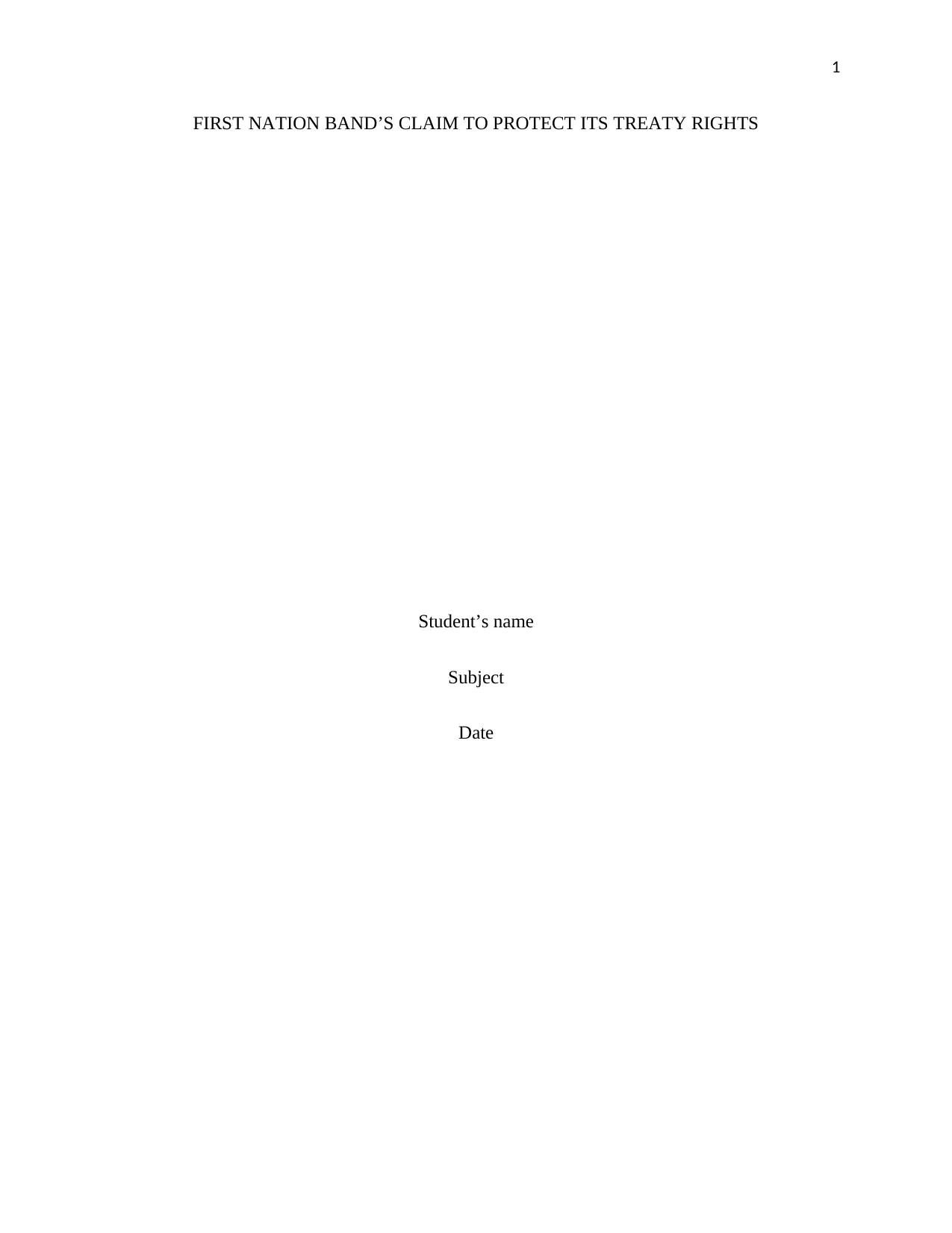
1
FIRST NATION BAND’S CLAIM TO PROTECT ITS TREATY RIGHTS
Student’s name
Subject
Date
FIRST NATION BAND’S CLAIM TO PROTECT ITS TREATY RIGHTS
Student’s name
Subject
Date
Paraphrase This Document
Need a fresh take? Get an instant paraphrase of this document with our AI Paraphraser
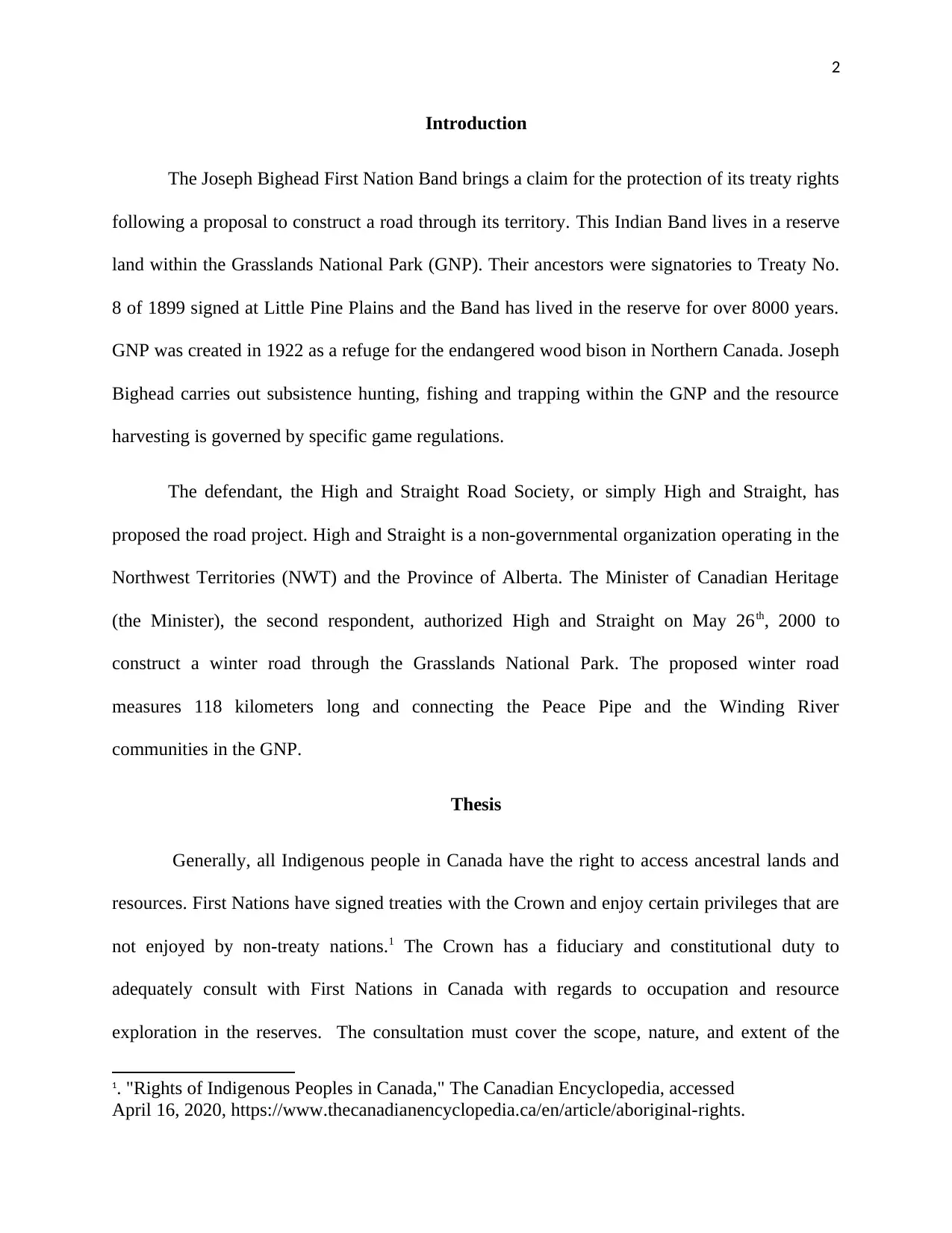
2
Introduction
The Joseph Bighead First Nation Band brings a claim for the protection of its treaty rights
following a proposal to construct a road through its territory. This Indian Band lives in a reserve
land within the Grasslands National Park (GNP). Their ancestors were signatories to Treaty No.
8 of 1899 signed at Little Pine Plains and the Band has lived in the reserve for over 8000 years.
GNP was created in 1922 as a refuge for the endangered wood bison in Northern Canada. Joseph
Bighead carries out subsistence hunting, fishing and trapping within the GNP and the resource
harvesting is governed by specific game regulations.
The defendant, the High and Straight Road Society, or simply High and Straight, has
proposed the road project. High and Straight is a non-governmental organization operating in the
Northwest Territories (NWT) and the Province of Alberta. The Minister of Canadian Heritage
(the Minister), the second respondent, authorized High and Straight on May 26th, 2000 to
construct a winter road through the Grasslands National Park. The proposed winter road
measures 118 kilometers long and connecting the Peace Pipe and the Winding River
communities in the GNP.
Thesis
Generally, all Indigenous people in Canada have the right to access ancestral lands and
resources. First Nations have signed treaties with the Crown and enjoy certain privileges that are
not enjoyed by non-treaty nations.1 The Crown has a fiduciary and constitutional duty to
adequately consult with First Nations in Canada with regards to occupation and resource
exploration in the reserves. The consultation must cover the scope, nature, and extent of the
1. "Rights of Indigenous Peoples in Canada," The Canadian Encyclopedia, accessed
April 16, 2020, https://www.thecanadianencyclopedia.ca/en/article/aboriginal-rights.
Introduction
The Joseph Bighead First Nation Band brings a claim for the protection of its treaty rights
following a proposal to construct a road through its territory. This Indian Band lives in a reserve
land within the Grasslands National Park (GNP). Their ancestors were signatories to Treaty No.
8 of 1899 signed at Little Pine Plains and the Band has lived in the reserve for over 8000 years.
GNP was created in 1922 as a refuge for the endangered wood bison in Northern Canada. Joseph
Bighead carries out subsistence hunting, fishing and trapping within the GNP and the resource
harvesting is governed by specific game regulations.
The defendant, the High and Straight Road Society, or simply High and Straight, has
proposed the road project. High and Straight is a non-governmental organization operating in the
Northwest Territories (NWT) and the Province of Alberta. The Minister of Canadian Heritage
(the Minister), the second respondent, authorized High and Straight on May 26th, 2000 to
construct a winter road through the Grasslands National Park. The proposed winter road
measures 118 kilometers long and connecting the Peace Pipe and the Winding River
communities in the GNP.
Thesis
Generally, all Indigenous people in Canada have the right to access ancestral lands and
resources. First Nations have signed treaties with the Crown and enjoy certain privileges that are
not enjoyed by non-treaty nations.1 The Crown has a fiduciary and constitutional duty to
adequately consult with First Nations in Canada with regards to occupation and resource
exploration in the reserves. The consultation must cover the scope, nature, and extent of the
1. "Rights of Indigenous Peoples in Canada," The Canadian Encyclopedia, accessed
April 16, 2020, https://www.thecanadianencyclopedia.ca/en/article/aboriginal-rights.
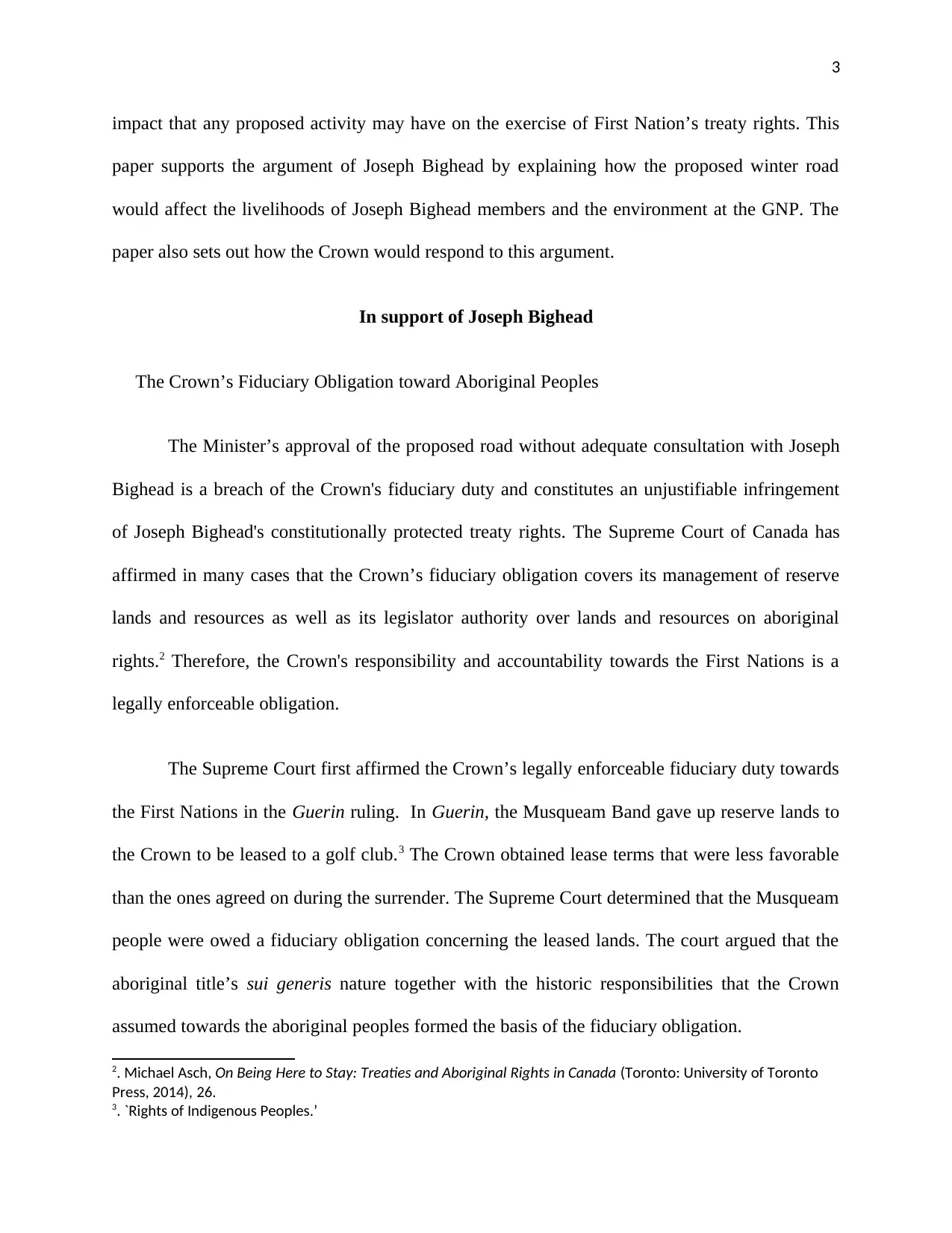
3
impact that any proposed activity may have on the exercise of First Nation’s treaty rights. This
paper supports the argument of Joseph Bighead by explaining how the proposed winter road
would affect the livelihoods of Joseph Bighead members and the environment at the GNP. The
paper also sets out how the Crown would respond to this argument.
In support of Joseph Bighead
The Crown’s Fiduciary Obligation toward Aboriginal Peoples
The Minister’s approval of the proposed road without adequate consultation with Joseph
Bighead is a breach of the Crown's fiduciary duty and constitutes an unjustifiable infringement
of Joseph Bighead's constitutionally protected treaty rights. The Supreme Court of Canada has
affirmed in many cases that the Crown’s fiduciary obligation covers its management of reserve
lands and resources as well as its legislator authority over lands and resources on aboriginal
rights.2 Therefore, the Crown's responsibility and accountability towards the First Nations is a
legally enforceable obligation.
The Supreme Court first affirmed the Crown’s legally enforceable fiduciary duty towards
the First Nations in the Guerin ruling. In Guerin, the Musqueam Band gave up reserve lands to
the Crown to be leased to a golf club.3 The Crown obtained lease terms that were less favorable
than the ones agreed on during the surrender. The Supreme Court determined that the Musqueam
people were owed a fiduciary obligation concerning the leased lands. The court argued that the
aboriginal title’s sui generis nature together with the historic responsibilities that the Crown
assumed towards the aboriginal peoples formed the basis of the fiduciary obligation.
2. Michael Asch, On Being Here to Stay: Treaties and Aboriginal Rights in Canada (Toronto: University of Toronto
Press, 2014), 26.
3. `Rights of Indigenous Peoples.’
impact that any proposed activity may have on the exercise of First Nation’s treaty rights. This
paper supports the argument of Joseph Bighead by explaining how the proposed winter road
would affect the livelihoods of Joseph Bighead members and the environment at the GNP. The
paper also sets out how the Crown would respond to this argument.
In support of Joseph Bighead
The Crown’s Fiduciary Obligation toward Aboriginal Peoples
The Minister’s approval of the proposed road without adequate consultation with Joseph
Bighead is a breach of the Crown's fiduciary duty and constitutes an unjustifiable infringement
of Joseph Bighead's constitutionally protected treaty rights. The Supreme Court of Canada has
affirmed in many cases that the Crown’s fiduciary obligation covers its management of reserve
lands and resources as well as its legislator authority over lands and resources on aboriginal
rights.2 Therefore, the Crown's responsibility and accountability towards the First Nations is a
legally enforceable obligation.
The Supreme Court first affirmed the Crown’s legally enforceable fiduciary duty towards
the First Nations in the Guerin ruling. In Guerin, the Musqueam Band gave up reserve lands to
the Crown to be leased to a golf club.3 The Crown obtained lease terms that were less favorable
than the ones agreed on during the surrender. The Supreme Court determined that the Musqueam
people were owed a fiduciary obligation concerning the leased lands. The court argued that the
aboriginal title’s sui generis nature together with the historic responsibilities that the Crown
assumed towards the aboriginal peoples formed the basis of the fiduciary obligation.
2. Michael Asch, On Being Here to Stay: Treaties and Aboriginal Rights in Canada (Toronto: University of Toronto
Press, 2014), 26.
3. `Rights of Indigenous Peoples.’
⊘ This is a preview!⊘
Do you want full access?
Subscribe today to unlock all pages.

Trusted by 1+ million students worldwide
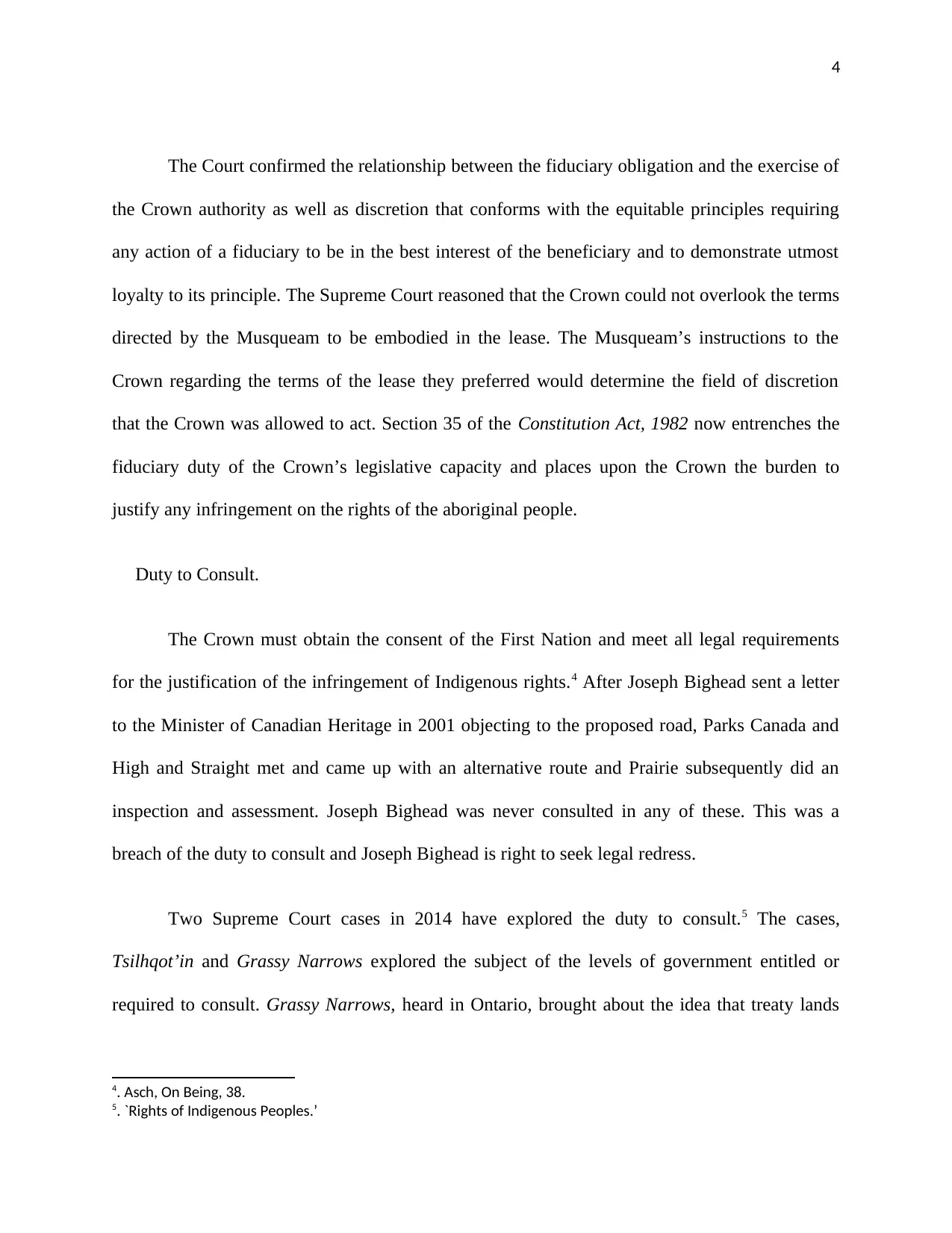
4
The Court confirmed the relationship between the fiduciary obligation and the exercise of
the Crown authority as well as discretion that conforms with the equitable principles requiring
any action of a fiduciary to be in the best interest of the beneficiary and to demonstrate utmost
loyalty to its principle. The Supreme Court reasoned that the Crown could not overlook the terms
directed by the Musqueam to be embodied in the lease. The Musqueam’s instructions to the
Crown regarding the terms of the lease they preferred would determine the field of discretion
that the Crown was allowed to act. Section 35 of the Constitution Act, 1982 now entrenches the
fiduciary duty of the Crown’s legislative capacity and places upon the Crown the burden to
justify any infringement on the rights of the aboriginal people.
Duty to Consult.
The Crown must obtain the consent of the First Nation and meet all legal requirements
for the justification of the infringement of Indigenous rights.4 After Joseph Bighead sent a letter
to the Minister of Canadian Heritage in 2001 objecting to the proposed road, Parks Canada and
High and Straight met and came up with an alternative route and Prairie subsequently did an
inspection and assessment. Joseph Bighead was never consulted in any of these. This was a
breach of the duty to consult and Joseph Bighead is right to seek legal redress.
Two Supreme Court cases in 2014 have explored the duty to consult.5 The cases,
Tsilhqot’in and Grassy Narrows explored the subject of the levels of government entitled or
required to consult. Grassy Narrows, heard in Ontario, brought about the idea that treaty lands
4. Asch, On Being, 38.
5. `Rights of Indigenous Peoples.’
The Court confirmed the relationship between the fiduciary obligation and the exercise of
the Crown authority as well as discretion that conforms with the equitable principles requiring
any action of a fiduciary to be in the best interest of the beneficiary and to demonstrate utmost
loyalty to its principle. The Supreme Court reasoned that the Crown could not overlook the terms
directed by the Musqueam to be embodied in the lease. The Musqueam’s instructions to the
Crown regarding the terms of the lease they preferred would determine the field of discretion
that the Crown was allowed to act. Section 35 of the Constitution Act, 1982 now entrenches the
fiduciary duty of the Crown’s legislative capacity and places upon the Crown the burden to
justify any infringement on the rights of the aboriginal people.
Duty to Consult.
The Crown must obtain the consent of the First Nation and meet all legal requirements
for the justification of the infringement of Indigenous rights.4 After Joseph Bighead sent a letter
to the Minister of Canadian Heritage in 2001 objecting to the proposed road, Parks Canada and
High and Straight met and came up with an alternative route and Prairie subsequently did an
inspection and assessment. Joseph Bighead was never consulted in any of these. This was a
breach of the duty to consult and Joseph Bighead is right to seek legal redress.
Two Supreme Court cases in 2014 have explored the duty to consult.5 The cases,
Tsilhqot’in and Grassy Narrows explored the subject of the levels of government entitled or
required to consult. Grassy Narrows, heard in Ontario, brought about the idea that treaty lands
4. Asch, On Being, 38.
5. `Rights of Indigenous Peoples.’
Paraphrase This Document
Need a fresh take? Get an instant paraphrase of this document with our AI Paraphraser
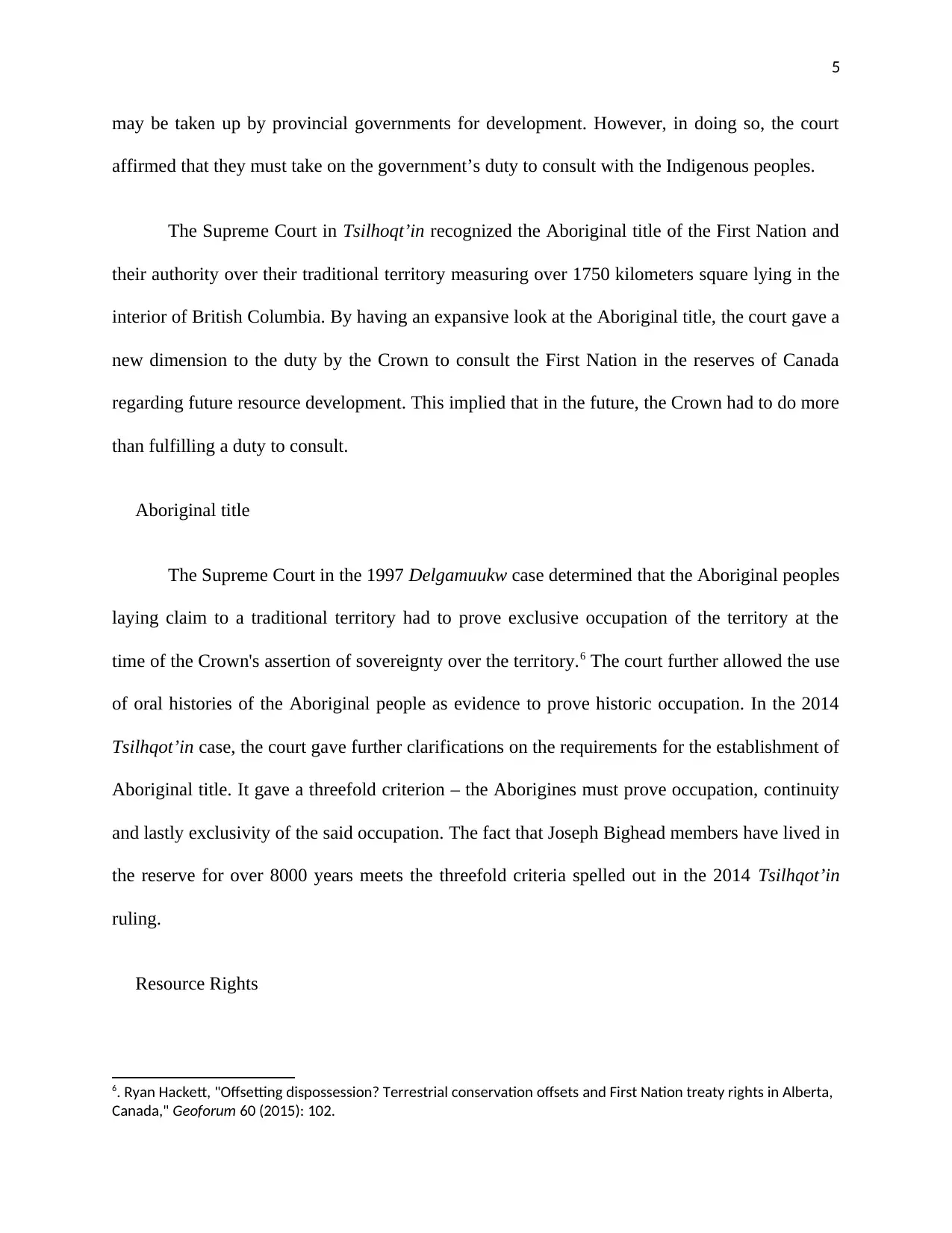
5
may be taken up by provincial governments for development. However, in doing so, the court
affirmed that they must take on the government’s duty to consult with the Indigenous peoples.
The Supreme Court in Tsilhoqt’in recognized the Aboriginal title of the First Nation and
their authority over their traditional territory measuring over 1750 kilometers square lying in the
interior of British Columbia. By having an expansive look at the Aboriginal title, the court gave a
new dimension to the duty by the Crown to consult the First Nation in the reserves of Canada
regarding future resource development. This implied that in the future, the Crown had to do more
than fulfilling a duty to consult.
Aboriginal title
The Supreme Court in the 1997 Delgamuukw case determined that the Aboriginal peoples
laying claim to a traditional territory had to prove exclusive occupation of the territory at the
time of the Crown's assertion of sovereignty over the territory.6 The court further allowed the use
of oral histories of the Aboriginal people as evidence to prove historic occupation. In the 2014
Tsilhqot’in case, the court gave further clarifications on the requirements for the establishment of
Aboriginal title. It gave a threefold criterion – the Aborigines must prove occupation, continuity
and lastly exclusivity of the said occupation. The fact that Joseph Bighead members have lived in
the reserve for over 8000 years meets the threefold criteria spelled out in the 2014 Tsilhqot’in
ruling.
Resource Rights
6. Ryan Hackett, "Offsetting dispossession? Terrestrial conservation offsets and First Nation treaty rights in Alberta,
Canada," Geoforum 60 (2015): 102.
may be taken up by provincial governments for development. However, in doing so, the court
affirmed that they must take on the government’s duty to consult with the Indigenous peoples.
The Supreme Court in Tsilhoqt’in recognized the Aboriginal title of the First Nation and
their authority over their traditional territory measuring over 1750 kilometers square lying in the
interior of British Columbia. By having an expansive look at the Aboriginal title, the court gave a
new dimension to the duty by the Crown to consult the First Nation in the reserves of Canada
regarding future resource development. This implied that in the future, the Crown had to do more
than fulfilling a duty to consult.
Aboriginal title
The Supreme Court in the 1997 Delgamuukw case determined that the Aboriginal peoples
laying claim to a traditional territory had to prove exclusive occupation of the territory at the
time of the Crown's assertion of sovereignty over the territory.6 The court further allowed the use
of oral histories of the Aboriginal people as evidence to prove historic occupation. In the 2014
Tsilhqot’in case, the court gave further clarifications on the requirements for the establishment of
Aboriginal title. It gave a threefold criterion – the Aborigines must prove occupation, continuity
and lastly exclusivity of the said occupation. The fact that Joseph Bighead members have lived in
the reserve for over 8000 years meets the threefold criteria spelled out in the 2014 Tsilhqot’in
ruling.
Resource Rights
6. Ryan Hackett, "Offsetting dispossession? Terrestrial conservation offsets and First Nation treaty rights in Alberta,
Canada," Geoforum 60 (2015): 102.
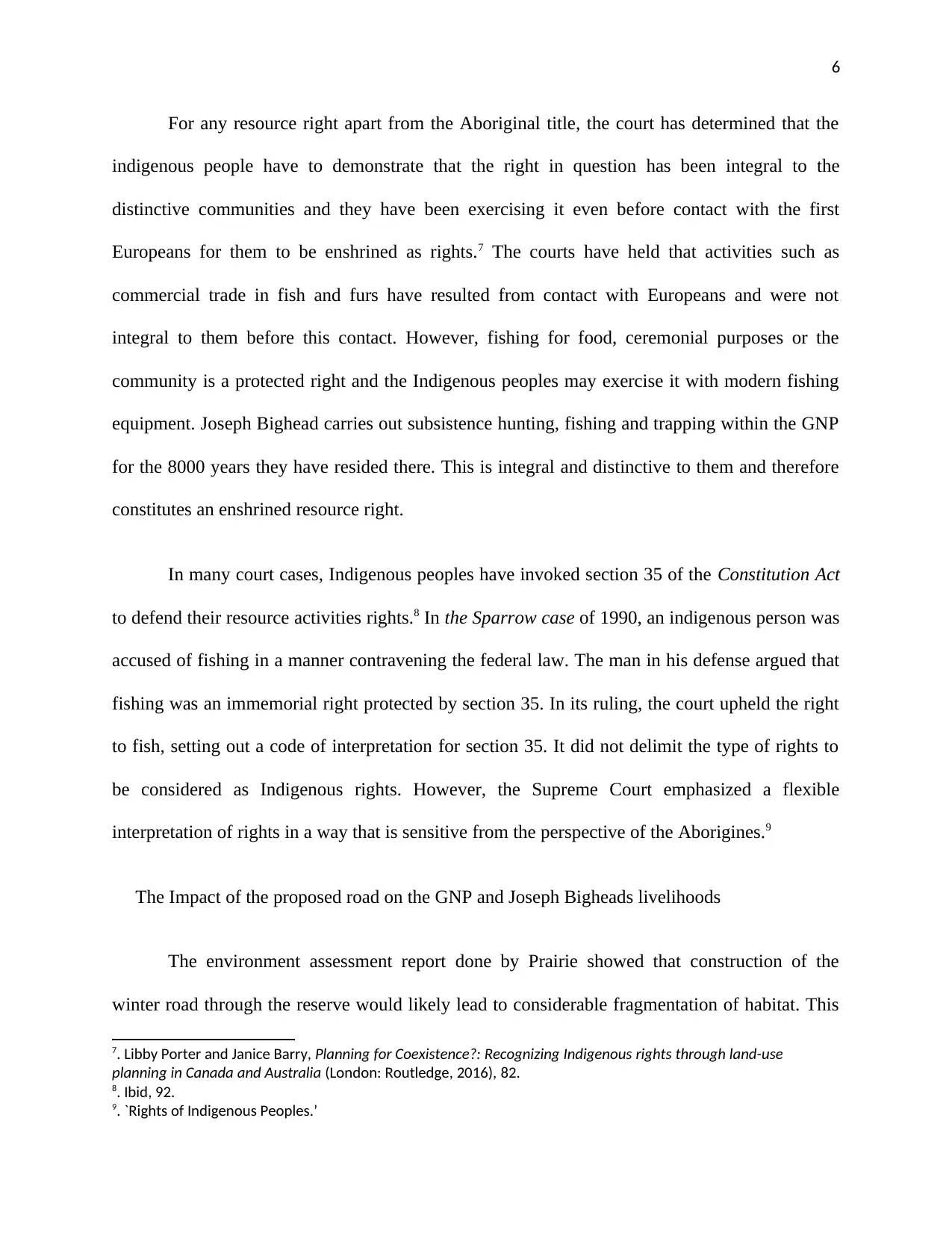
6
For any resource right apart from the Aboriginal title, the court has determined that the
indigenous people have to demonstrate that the right in question has been integral to the
distinctive communities and they have been exercising it even before contact with the first
Europeans for them to be enshrined as rights.7 The courts have held that activities such as
commercial trade in fish and furs have resulted from contact with Europeans and were not
integral to them before this contact. However, fishing for food, ceremonial purposes or the
community is a protected right and the Indigenous peoples may exercise it with modern fishing
equipment. Joseph Bighead carries out subsistence hunting, fishing and trapping within the GNP
for the 8000 years they have resided there. This is integral and distinctive to them and therefore
constitutes an enshrined resource right.
In many court cases, Indigenous peoples have invoked section 35 of the Constitution Act
to defend their resource activities rights.8 In the Sparrow case of 1990, an indigenous person was
accused of fishing in a manner contravening the federal law. The man in his defense argued that
fishing was an immemorial right protected by section 35. In its ruling, the court upheld the right
to fish, setting out a code of interpretation for section 35. It did not delimit the type of rights to
be considered as Indigenous rights. However, the Supreme Court emphasized a flexible
interpretation of rights in a way that is sensitive from the perspective of the Aborigines.9
The Impact of the proposed road on the GNP and Joseph Bigheads livelihoods
The environment assessment report done by Prairie showed that construction of the
winter road through the reserve would likely lead to considerable fragmentation of habitat. This
7. Libby Porter and Janice Barry, Planning for Coexistence?: Recognizing Indigenous rights through land-use
planning in Canada and Australia (London: Routledge, 2016), 82.
8. Ibid, 92.
9. `Rights of Indigenous Peoples.’
For any resource right apart from the Aboriginal title, the court has determined that the
indigenous people have to demonstrate that the right in question has been integral to the
distinctive communities and they have been exercising it even before contact with the first
Europeans for them to be enshrined as rights.7 The courts have held that activities such as
commercial trade in fish and furs have resulted from contact with Europeans and were not
integral to them before this contact. However, fishing for food, ceremonial purposes or the
community is a protected right and the Indigenous peoples may exercise it with modern fishing
equipment. Joseph Bighead carries out subsistence hunting, fishing and trapping within the GNP
for the 8000 years they have resided there. This is integral and distinctive to them and therefore
constitutes an enshrined resource right.
In many court cases, Indigenous peoples have invoked section 35 of the Constitution Act
to defend their resource activities rights.8 In the Sparrow case of 1990, an indigenous person was
accused of fishing in a manner contravening the federal law. The man in his defense argued that
fishing was an immemorial right protected by section 35. In its ruling, the court upheld the right
to fish, setting out a code of interpretation for section 35. It did not delimit the type of rights to
be considered as Indigenous rights. However, the Supreme Court emphasized a flexible
interpretation of rights in a way that is sensitive from the perspective of the Aborigines.9
The Impact of the proposed road on the GNP and Joseph Bigheads livelihoods
The environment assessment report done by Prairie showed that construction of the
winter road through the reserve would likely lead to considerable fragmentation of habitat. This
7. Libby Porter and Janice Barry, Planning for Coexistence?: Recognizing Indigenous rights through land-use
planning in Canada and Australia (London: Routledge, 2016), 82.
8. Ibid, 92.
9. `Rights of Indigenous Peoples.’
⊘ This is a preview!⊘
Do you want full access?
Subscribe today to unlock all pages.

Trusted by 1+ million students worldwide
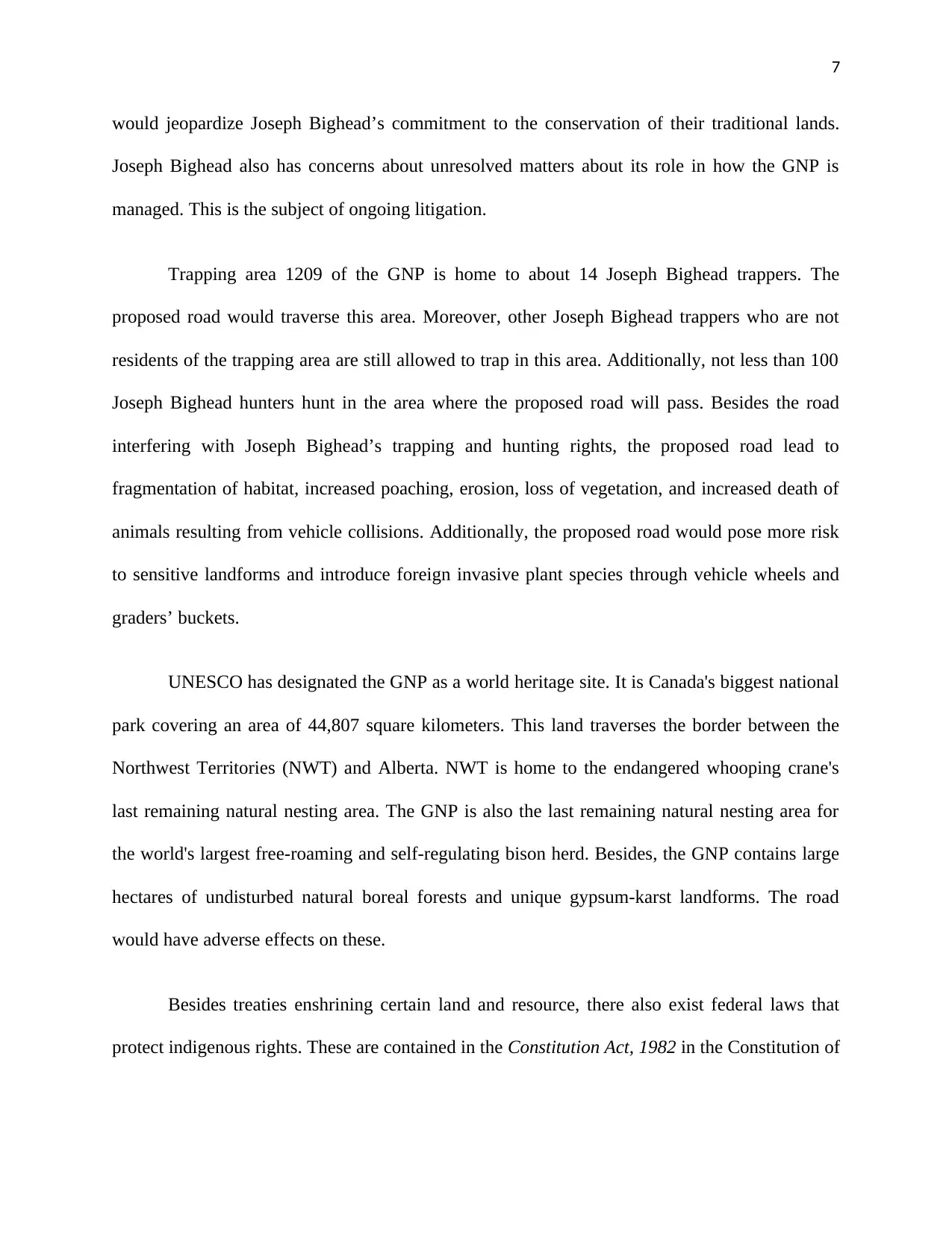
7
would jeopardize Joseph Bighead’s commitment to the conservation of their traditional lands.
Joseph Bighead also has concerns about unresolved matters about its role in how the GNP is
managed. This is the subject of ongoing litigation.
Trapping area 1209 of the GNP is home to about 14 Joseph Bighead trappers. The
proposed road would traverse this area. Moreover, other Joseph Bighead trappers who are not
residents of the trapping area are still allowed to trap in this area. Additionally, not less than 100
Joseph Bighead hunters hunt in the area where the proposed road will pass. Besides the road
interfering with Joseph Bighead’s trapping and hunting rights, the proposed road lead to
fragmentation of habitat, increased poaching, erosion, loss of vegetation, and increased death of
animals resulting from vehicle collisions. Additionally, the proposed road would pose more risk
to sensitive landforms and introduce foreign invasive plant species through vehicle wheels and
graders’ buckets.
UNESCO has designated the GNP as a world heritage site. It is Canada's biggest national
park covering an area of 44,807 square kilometers. This land traverses the border between the
Northwest Territories (NWT) and Alberta. NWT is home to the endangered whooping crane's
last remaining natural nesting area. The GNP is also the last remaining natural nesting area for
the world's largest free-roaming and self-regulating bison herd. Besides, the GNP contains large
hectares of undisturbed natural boreal forests and unique gypsum-karst landforms. The road
would have adverse effects on these.
Besides treaties enshrining certain land and resource, there also exist federal laws that
protect indigenous rights. These are contained in the Constitution Act, 1982 in the Constitution of
would jeopardize Joseph Bighead’s commitment to the conservation of their traditional lands.
Joseph Bighead also has concerns about unresolved matters about its role in how the GNP is
managed. This is the subject of ongoing litigation.
Trapping area 1209 of the GNP is home to about 14 Joseph Bighead trappers. The
proposed road would traverse this area. Moreover, other Joseph Bighead trappers who are not
residents of the trapping area are still allowed to trap in this area. Additionally, not less than 100
Joseph Bighead hunters hunt in the area where the proposed road will pass. Besides the road
interfering with Joseph Bighead’s trapping and hunting rights, the proposed road lead to
fragmentation of habitat, increased poaching, erosion, loss of vegetation, and increased death of
animals resulting from vehicle collisions. Additionally, the proposed road would pose more risk
to sensitive landforms and introduce foreign invasive plant species through vehicle wheels and
graders’ buckets.
UNESCO has designated the GNP as a world heritage site. It is Canada's biggest national
park covering an area of 44,807 square kilometers. This land traverses the border between the
Northwest Territories (NWT) and Alberta. NWT is home to the endangered whooping crane's
last remaining natural nesting area. The GNP is also the last remaining natural nesting area for
the world's largest free-roaming and self-regulating bison herd. Besides, the GNP contains large
hectares of undisturbed natural boreal forests and unique gypsum-karst landforms. The road
would have adverse effects on these.
Besides treaties enshrining certain land and resource, there also exist federal laws that
protect indigenous rights. These are contained in the Constitution Act, 1982 in the Constitution of
Paraphrase This Document
Need a fresh take? Get an instant paraphrase of this document with our AI Paraphraser
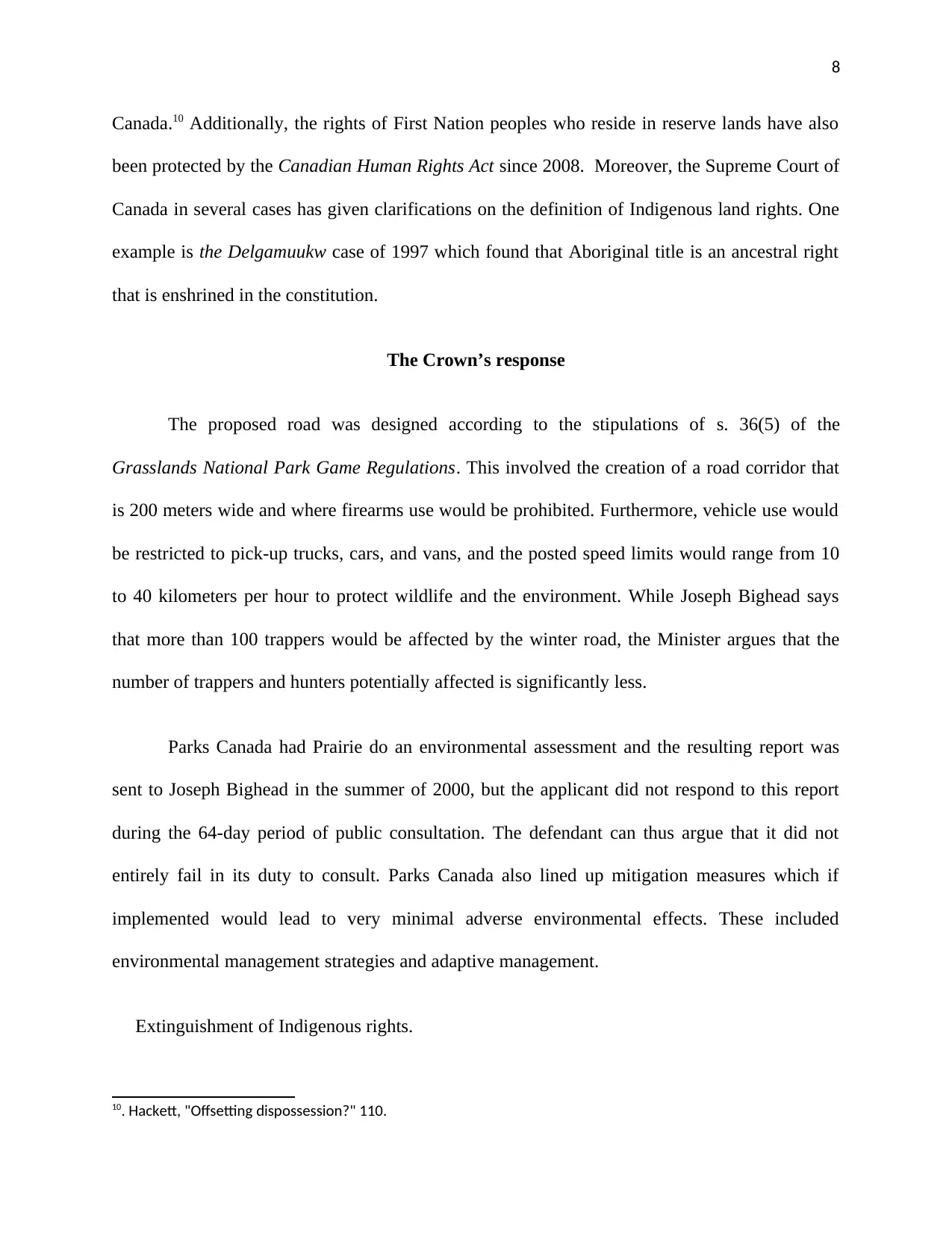
8
Canada.10 Additionally, the rights of First Nation peoples who reside in reserve lands have also
been protected by the Canadian Human Rights Act since 2008. Moreover, the Supreme Court of
Canada in several cases has given clarifications on the definition of Indigenous land rights. One
example is the Delgamuukw case of 1997 which found that Aboriginal title is an ancestral right
that is enshrined in the constitution.
The Crown’s response
The proposed road was designed according to the stipulations of s. 36(5) of the
Grasslands National Park Game Regulations. This involved the creation of a road corridor that
is 200 meters wide and where firearms use would be prohibited. Furthermore, vehicle use would
be restricted to pick-up trucks, cars, and vans, and the posted speed limits would range from 10
to 40 kilometers per hour to protect wildlife and the environment. While Joseph Bighead says
that more than 100 trappers would be affected by the winter road, the Minister argues that the
number of trappers and hunters potentially affected is significantly less.
Parks Canada had Prairie do an environmental assessment and the resulting report was
sent to Joseph Bighead in the summer of 2000, but the applicant did not respond to this report
during the 64-day period of public consultation. The defendant can thus argue that it did not
entirely fail in its duty to consult. Parks Canada also lined up mitigation measures which if
implemented would lead to very minimal adverse environmental effects. These included
environmental management strategies and adaptive management.
Extinguishment of Indigenous rights.
10. Hackett, "Offsetting dispossession?" 110.
Canada.10 Additionally, the rights of First Nation peoples who reside in reserve lands have also
been protected by the Canadian Human Rights Act since 2008. Moreover, the Supreme Court of
Canada in several cases has given clarifications on the definition of Indigenous land rights. One
example is the Delgamuukw case of 1997 which found that Aboriginal title is an ancestral right
that is enshrined in the constitution.
The Crown’s response
The proposed road was designed according to the stipulations of s. 36(5) of the
Grasslands National Park Game Regulations. This involved the creation of a road corridor that
is 200 meters wide and where firearms use would be prohibited. Furthermore, vehicle use would
be restricted to pick-up trucks, cars, and vans, and the posted speed limits would range from 10
to 40 kilometers per hour to protect wildlife and the environment. While Joseph Bighead says
that more than 100 trappers would be affected by the winter road, the Minister argues that the
number of trappers and hunters potentially affected is significantly less.
Parks Canada had Prairie do an environmental assessment and the resulting report was
sent to Joseph Bighead in the summer of 2000, but the applicant did not respond to this report
during the 64-day period of public consultation. The defendant can thus argue that it did not
entirely fail in its duty to consult. Parks Canada also lined up mitigation measures which if
implemented would lead to very minimal adverse environmental effects. These included
environmental management strategies and adaptive management.
Extinguishment of Indigenous rights.
10. Hackett, "Offsetting dispossession?" 110.
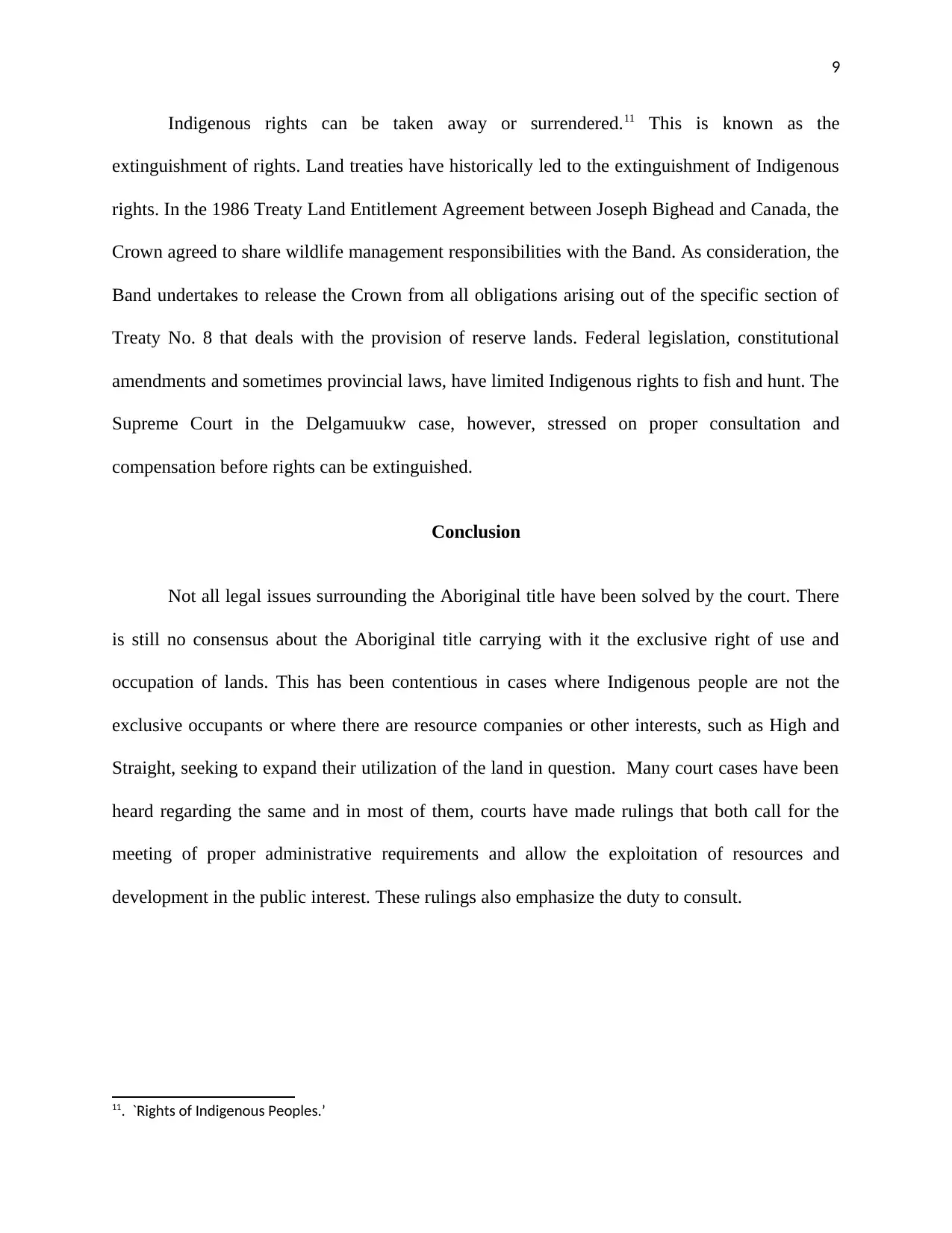
9
Indigenous rights can be taken away or surrendered.11 This is known as the
extinguishment of rights. Land treaties have historically led to the extinguishment of Indigenous
rights. In the 1986 Treaty Land Entitlement Agreement between Joseph Bighead and Canada, the
Crown agreed to share wildlife management responsibilities with the Band. As consideration, the
Band undertakes to release the Crown from all obligations arising out of the specific section of
Treaty No. 8 that deals with the provision of reserve lands. Federal legislation, constitutional
amendments and sometimes provincial laws, have limited Indigenous rights to fish and hunt. The
Supreme Court in the Delgamuukw case, however, stressed on proper consultation and
compensation before rights can be extinguished.
Conclusion
Not all legal issues surrounding the Aboriginal title have been solved by the court. There
is still no consensus about the Aboriginal title carrying with it the exclusive right of use and
occupation of lands. This has been contentious in cases where Indigenous people are not the
exclusive occupants or where there are resource companies or other interests, such as High and
Straight, seeking to expand their utilization of the land in question. Many court cases have been
heard regarding the same and in most of them, courts have made rulings that both call for the
meeting of proper administrative requirements and allow the exploitation of resources and
development in the public interest. These rulings also emphasize the duty to consult.
11. `Rights of Indigenous Peoples.’
Indigenous rights can be taken away or surrendered.11 This is known as the
extinguishment of rights. Land treaties have historically led to the extinguishment of Indigenous
rights. In the 1986 Treaty Land Entitlement Agreement between Joseph Bighead and Canada, the
Crown agreed to share wildlife management responsibilities with the Band. As consideration, the
Band undertakes to release the Crown from all obligations arising out of the specific section of
Treaty No. 8 that deals with the provision of reserve lands. Federal legislation, constitutional
amendments and sometimes provincial laws, have limited Indigenous rights to fish and hunt. The
Supreme Court in the Delgamuukw case, however, stressed on proper consultation and
compensation before rights can be extinguished.
Conclusion
Not all legal issues surrounding the Aboriginal title have been solved by the court. There
is still no consensus about the Aboriginal title carrying with it the exclusive right of use and
occupation of lands. This has been contentious in cases where Indigenous people are not the
exclusive occupants or where there are resource companies or other interests, such as High and
Straight, seeking to expand their utilization of the land in question. Many court cases have been
heard regarding the same and in most of them, courts have made rulings that both call for the
meeting of proper administrative requirements and allow the exploitation of resources and
development in the public interest. These rulings also emphasize the duty to consult.
11. `Rights of Indigenous Peoples.’
⊘ This is a preview!⊘
Do you want full access?
Subscribe today to unlock all pages.

Trusted by 1+ million students worldwide
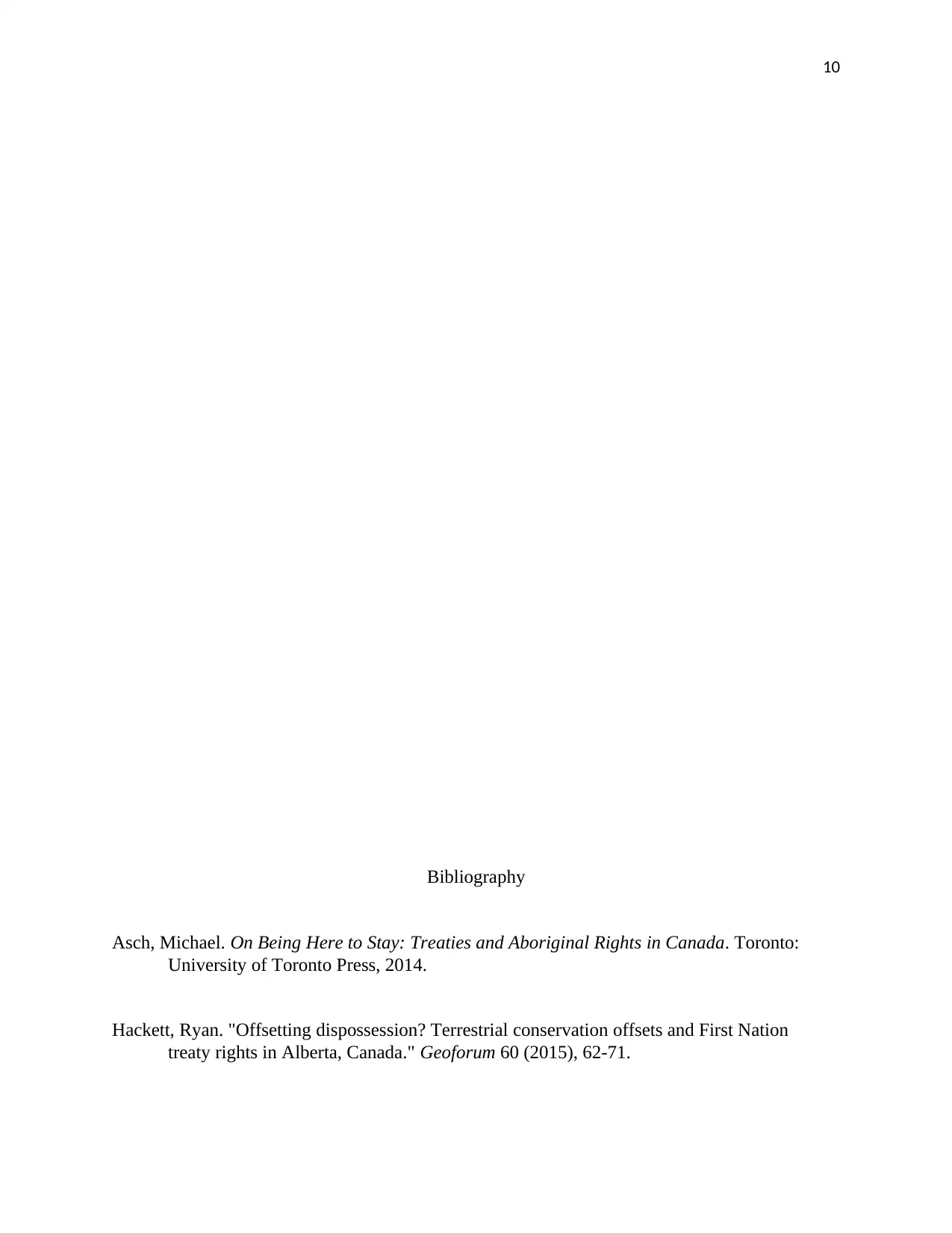
10
Bibliography
Asch, Michael. On Being Here to Stay: Treaties and Aboriginal Rights in Canada. Toronto:
University of Toronto Press, 2014.
Hackett, Ryan. "Offsetting dispossession? Terrestrial conservation offsets and First Nation
treaty rights in Alberta, Canada." Geoforum 60 (2015), 62-71.
Bibliography
Asch, Michael. On Being Here to Stay: Treaties and Aboriginal Rights in Canada. Toronto:
University of Toronto Press, 2014.
Hackett, Ryan. "Offsetting dispossession? Terrestrial conservation offsets and First Nation
treaty rights in Alberta, Canada." Geoforum 60 (2015), 62-71.
Paraphrase This Document
Need a fresh take? Get an instant paraphrase of this document with our AI Paraphraser
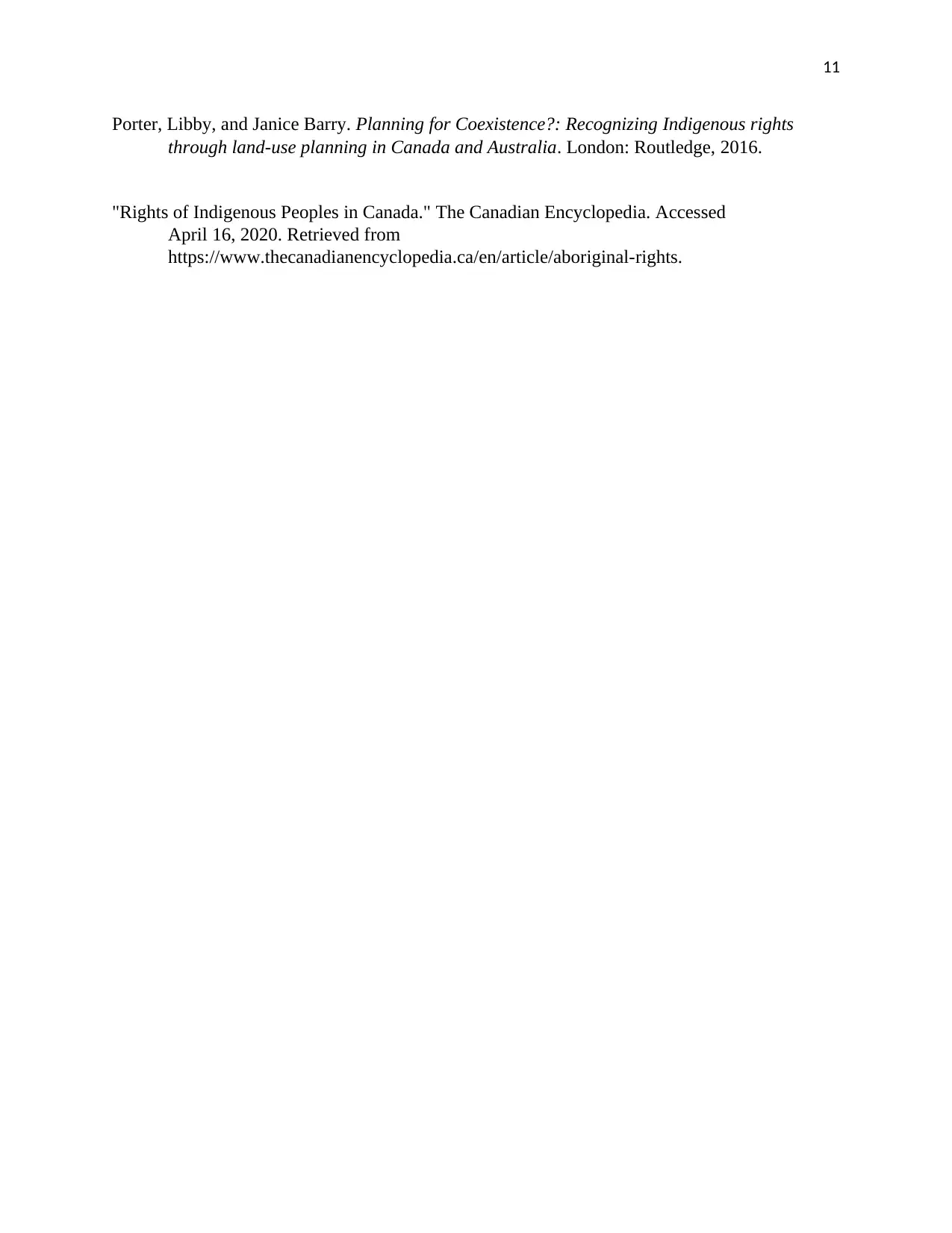
11
Porter, Libby, and Janice Barry. Planning for Coexistence?: Recognizing Indigenous rights
through land-use planning in Canada and Australia. London: Routledge, 2016.
"Rights of Indigenous Peoples in Canada." The Canadian Encyclopedia. Accessed
April 16, 2020. Retrieved from
https://www.thecanadianencyclopedia.ca/en/article/aboriginal-rights.
Porter, Libby, and Janice Barry. Planning for Coexistence?: Recognizing Indigenous rights
through land-use planning in Canada and Australia. London: Routledge, 2016.
"Rights of Indigenous Peoples in Canada." The Canadian Encyclopedia. Accessed
April 16, 2020. Retrieved from
https://www.thecanadianencyclopedia.ca/en/article/aboriginal-rights.
1 out of 11
Your All-in-One AI-Powered Toolkit for Academic Success.
+13062052269
info@desklib.com
Available 24*7 on WhatsApp / Email
![[object Object]](/_next/static/media/star-bottom.7253800d.svg)
Unlock your academic potential
Copyright © 2020–2025 A2Z Services. All Rights Reserved. Developed and managed by ZUCOL.
